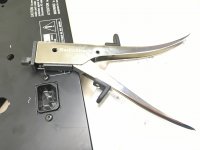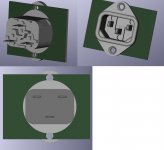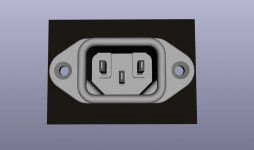Hi, I'm looking for a round AC power IEC connector. I kept looking for different makers but they all need a square cutout, I need a round cutout to be able to execute it with a bench drill with a conical drill. Can you direct me to a site where I can find something like that?
This would be really good to have vpower16v. Cutting the rectangular hole for the IEC connector is quite tedious... 🙂
Let us see what the good people of the forum can suggest us.
One option is to use a Powercon connector, but that is more expensive.
Let us see what the good people of the forum can suggest us.
One option is to use a Powercon connector, but that is more expensive.
Last edited:
Hi I don't think these exist in round form. At least not when I looked for them years ago. There are some odd ones but these are equally difficult to cut out:
https://docs.rs-online.com/e9fd/0900766b81552b68.pdf
I think your option is indeed Powercon. I fully understand your frustration as it is a time consuming job with hand tools. Worse is that the shape and size of the rectangular hole also is not standardized.
https://docs.rs-online.com/e9fd/0900766b81552b68.pdf
I think your option is indeed Powercon. I fully understand your frustration as it is a time consuming job with hand tools. Worse is that the shape and size of the rectangular hole also is not standardized.
Last edited:
I usually drill 3mm holes around the inner perimeter of the square gude line and then straighten the edges with file of different sizes. Of course, do not rush and occasionally check with socket - does it fit.
Most of us do it like that. Of course one gets the hang of it after having done a few but it still takes too much time to even think of a series of a device.
Thank you guys for the ideas. Yeah, I know that all kinds of cuts can be made with the help of a drill and hole near hole and after that with a file you smooth it, but they are not professional solutions.
@jean-paul I also looked at the connector from the schurter but I saw that it does not correspond to the typical IEC connector for audio power cables. The IEC connector has the ground pin above the phase and null, but the schurter has them in line.
@zman01 I like neutrik connectors very much and powercon is an exceptional connector and i use them where i can, but it is not user friendly for regular consumers and the cable cannot be easily swaped.
Regards, Vlad
@jean-paul I also looked at the connector from the schurter but I saw that it does not correspond to the typical IEC connector for audio power cables. The IEC connector has the ground pin above the phase and null, but the schurter has them in line.
@zman01 I like neutrik connectors very much and powercon is an exceptional connector and i use them where i can, but it is not user friendly for regular consumers and the cable cannot be easily swaped.
Regards, Vlad
but they are not professional solutions.
I will have to take issue with that. It is perfectly possible to produce a very accurate a.k.a. "professional" work with a hacksaw and files. Engineering apprentices have to be able to do it still I believe. I am not a trained engineer, but I am capable of cutting a professional looking hole for an IEC connector. Of course there is some margin for inaccuracy as the edges of the hole are hidden by the flange of the connector. Also, as with all metal work, accurate marking out before cutting is very important.
I use a 1/2" square chassis punch. 4 punches are required in the hole corners.
To protect the expensive punch place a same thickness of the same material as the work under the unsupported work edges of the boss, this prevent kinking. Lubricate the boss, die and threads of the tool.
With a little care you get a professional finish. E
To protect the expensive punch place a same thickness of the same material as the work under the unsupported work edges of the boss, this prevent kinking. Lubricate the boss, die and threads of the tool.
With a little care you get a professional finish. E
Interestingly enough those punches cost more than I would expect to pay for a custom made one! I did have one made for a bench punch press that did Neutrik D series connectors. I made a mistake in having all three holes punched at once. Two mounting holes were much smaller than the main hole. Seems to result in those punch parts snapping off!
So if wanting a production method for up to a few hundred I would have a punch and die set made for the center hole and mount it in a hand press. All of that should cost less than some of the fancy hand punches. Much less than the hand punch with a hydraulic power unit.
Way less if you find used pieces!
Myself I started with chassis punches, then got a hand operated press. Now I have a turret press and can nibble punch IEC holes easily. Of course a turret press new, last I looked, started at $185,000.00! Used under $10,000.00!
If you have a local sheet metal shop the may be able to punch an adapter ring for you at a reasonable price.
The diyAudio store (or a group buy) could get made low cost laser-cut IEC mounting plates
that fit in a round hole.
that fit in a round hole.
Last edited:
"If you want to distribute them, just let me know how many."
I think it could be popular enough for the diyAudio store, how can we find out if they would be interested?
Maybe a minimum purchase of ten per person would help. From my free parts giveaway recent experience,
it's a lot of work for an individual to do, but I might be willing if no one else would.
Single plates could be mailed in an envelope first class in the USA for probably a couple of stamps.
I think it could be popular enough for the diyAudio store, how can we find out if they would be interested?
Maybe a minimum purchase of ten per person would help. From my free parts giveaway recent experience,
it's a lot of work for an individual to do, but I might be willing if no one else would.
Single plates could be mailed in an envelope first class in the USA for probably a couple of stamps.
Let’s not pretend like this isn’t a huge problem, all of my vintage gear would have a proper plug sockets on them if this weren’t a giant PITA...I haven’t been able to find a round hole either but someone must make this?
There are these, and a standard IEC plug will fit it, but a proper round female cord mounted connector is best.
https://www.homedepot.com/p/AC-WORK...p9hx7-FKJRC-Mt1Qax8aAnxfEALw_wcB&gclsrc=aw.ds
https://www.homedepot.com/p/AC-WORK...p9hx7-FKJRC-Mt1Qax8aAnxfEALw_wcB&gclsrc=aw.ds
I think a nibbler and using a flange could give you professional results if you're selling on a scale that limits you to only using round holes and not spending a few hundred dollars on adapter plates.
The Bulgin PX0579 socket was recommended on a guitar website as a replacement for vintage gear, and it looks like you could just fit it in a 29mm - 29.5mm hole while keeping the edges hidden by the 30mm flange. Some basic Kicad 3D work to show that attached. The mounting holes end up intersecting, but it looks manageable.
If you're trying to sell the things you're making, you could probably have a adapter plates made for less than the cost of a punch. Try places like Ponoko.
You could even make an adapter plate as a PCB, if that's easier for you. PCB vendors don't charge much (if any) extra for making non-plated cutouts, so you could get them green, get them with no mask, pay a little extra for a black mask, add copper planes for shielding. I could make a board if someone wanted to do this, but a laser-cutting vendor with aluminum sounds better to me.
Since this is obviously a desired thing for DIY, maybe DIYaudio will make them, or you could email Angela Instruments, Mojotone, or anywhere else that already offers adapter plates for tube sockets to see if they're willing to invest in making some IEC adapter plates.
There are also some wall plates available, but they're inefficiently large and not very attractive.
The Bulgin PX0579 socket was recommended on a guitar website as a replacement for vintage gear, and it looks like you could just fit it in a 29mm - 29.5mm hole while keeping the edges hidden by the 30mm flange. Some basic Kicad 3D work to show that attached. The mounting holes end up intersecting, but it looks manageable.
If you're trying to sell the things you're making, you could probably have a adapter plates made for less than the cost of a punch. Try places like Ponoko.
You could even make an adapter plate as a PCB, if that's easier for you. PCB vendors don't charge much (if any) extra for making non-plated cutouts, so you could get them green, get them with no mask, pay a little extra for a black mask, add copper planes for shielding. I could make a board if someone wanted to do this, but a laser-cutting vendor with aluminum sounds better to me.
Since this is obviously a desired thing for DIY, maybe DIYaudio will make them, or you could email Angela Instruments, Mojotone, or anywhere else that already offers adapter plates for tube sockets to see if they're willing to invest in making some IEC adapter plates.
There are also some wall plates available, but they're inefficiently large and not very attractive.
Attachments
Not sure standard thickness pcb material would be mechanically strong enough for the pushing and
twisting that the IEC sockets need. I'd use 1/16" steel with 4 mounting bolts. Should be made to work
with a 1U chassis, or higher.
twisting that the IEC sockets need. I'd use 1/16" steel with 4 mounting bolts. Should be made to work
with a 1U chassis, or higher.
Last edited:
I agree that PCB material isn't ideal for this, but depending on intended use, resources, and comfort level, it could preferable for someone's personal projects.
For a standard IEC connector with mounting holes 40mm apart, you can use a 1.25" round hole, but you see the hole. To make an adapter plate that fits on a 1U case you'd just want a vanity plate that shared mounting holes with the connector. This also makes it smaller and the sturdiness of the material no longer matters very much. It can be made more attractive than a sharp-cornered rectangle.
If you wanted to mount the connector independently on the plate, you'd need a circular panel cutout too large for a 1U chassis to get around the 40mm mounting screws. This only applies to what I consider the most standard style of connector. Using a snap-in or the Bulgin with the vertical mounting holes would be fine with 1U.
For a standard IEC connector with mounting holes 40mm apart, you can use a 1.25" round hole, but you see the hole. To make an adapter plate that fits on a 1U case you'd just want a vanity plate that shared mounting holes with the connector. This also makes it smaller and the sturdiness of the material no longer matters very much. It can be made more attractive than a sharp-cornered rectangle.
If you wanted to mount the connector independently on the plate, you'd need a circular panel cutout too large for a 1U chassis to get around the 40mm mounting screws. This only applies to what I consider the most standard style of connector. Using a snap-in or the Bulgin with the vertical mounting holes would be fine with 1U.
Attachments
- Home
- Design & Build
- Parts
- Round cutout IEC connector



